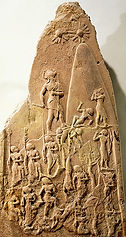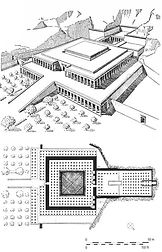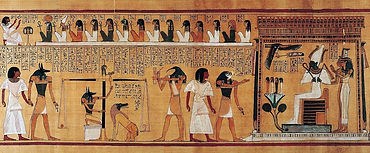Kuntz
AP Art History
AP

13. Palette of King Narmer. Predynastic Egypt. c. 3000–2920 B.C.E. Greywacke, height 25”. Egyptian Museum, Cairo, Egypt.

The Step Pyramid of Djoser, Funerary Complex of Djoser, Saqqara, Egypt. Designed by Imhotep, Third Dynasty, 2630-2575 BCE, limestne, height of pyramid 204'

The Step Pyramid of Djoser, Funerary Complex of Djoser, Saqqara, Egypt. Designed by Imhotep, Third Dynasty, 2630-2575 BCE, limestne, height of pyramid 204'

15. Seated scribe. Saqqara, Egypt. Old Kingdom, Fourth Dynasty. c. 2620–2500 B.C.E. Painted limestone, height 21”. Musee du Louvre, Paris, France.

15. Seated scribe. Saqqara, Egypt. Old Kingdom, Fourth Dynasty. c. 2620–2500 B.C.E. Painted limestone, height 21”. Musee du Louvre, Paris, France.

17. Great Pyramids (Menkaura, Khafre, Khufu) and Great Sphinx. Giza, Egypt. Old Kingdom,Fourth Dynasty. c. 2550–2490 B.C.E. Cut limestone, 450’, height of Great Sphinx, 65’.

17. Great Pyramids (Menkaura, Khafre, Khufu) and Great Sphinx. Giza, Egypt. Old Kingdom,Fourth Dynasty. c. 2550–2490 B.C.E. Cut limestone, 450’, height of Great Sphinx, 65’.

18. King Menkaura and queen. Old Kingdom, Fourth Dynasty. c. 2490–2472 B.C.E. Greywacke with traces of red and black paint, height 54 ½”. Museum of Fine Arts, Boston, Massachusetts.

20. Temple of Amun-Re and Hypostyle Hall. Karnak, near Luxor, Egypt. New Kingdom, 18th and 19th Dynasties. Temple: c. 1550 B.C.E.; hall: c. 1250 B.C.E. Cut sandstone and mud brick, complex 247 acres (an acre is 76% of a football field, with end zones), walls 39’ high x 26’ thick; hall 58,000 sq. feet, 12 central columns 75’ high, capitals diameter 22’.
CONTENT: What do you see?
FORM: The details (what you see more exactly). How the artist delivers the content.
CONTEXT: Everything NOT observable.
FUNCTION: The intended purpose of the work.
Assignments:
READINGS:
UNIT SHEET: below
SNAPSHOT Sheet::
Egypt Unit Sheet
APAH 250 Images:
13. Palette of King Narmer
15. Seated scribe
17. Great Pyramids and Sphinx
-plan
18. King Menkaura and Queen
20. Temple of Amun Re at Karnak
-plan
-Hypostyle hall
21. Mortuary Temple of Hatshepsut
-Kneeling statue
22. Akenaton, Nefertiti, and three daughters
23. Tutankhamun's tomb, innermost coffin
24. Last Judgement of Hu-Nefer,
Book of the Dead
.Additional Images
Seated Ka Statue of Khafre
Temple of Ramses II
Statue of Akenaton

Ancient Egypt Unit Sheet:
What is a conceptual view?
An image that shows all important parts and represents what is know to be true of the subject.

What is an optical view?
How something would actually stand in space, a random view of it.


What is twisted perspective?
A convention of representation where part of a figure is shown in profile and another part of the same figure is shown frontally.

What is an axial plan?
In an axial plan, the parts of a building are organized longitudinally, or along a given axis; in a central plan, the parts of the structure are of equal or almost equal dimensions around the center.



What is a composite view?
A convention of representation where part of a figure is shown in profile and another part of the same figure is shown frontally.

What is a convention?
A way in which something is usually done, such as registers.
